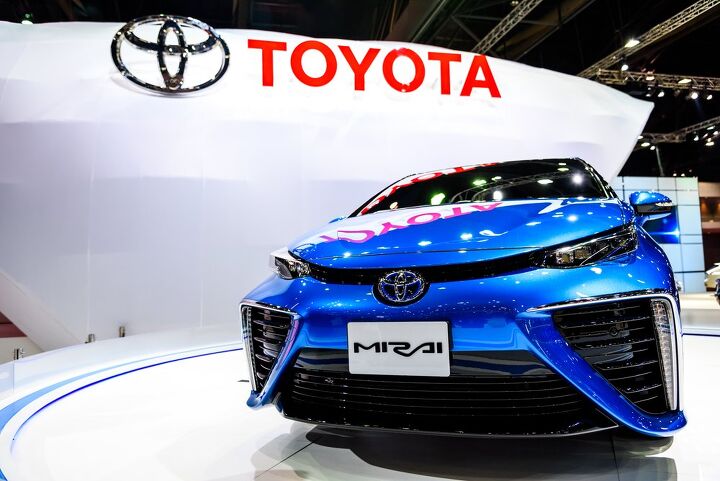Why Do Japanese Automakers Like Hydrogen Power?

Honda, Suzuki, Kawasaki, and Yamaha have just collectively promised to develop a slew of hydrogen-reliant engines designed to power small vehicles. While this is supposed to encompass construction equipment, small boats, airborne drones, and even motorcycles, the scheme doesn’t seem to focus on automobiles. However, Japanese automakers have already been working on hydrogen fuel cell vehicles for years and Toyota Chairman Akio Toyoda has even been championing the development of hydrogen-burning motors for some of the brand's racing applications.
It’s largely counter to what the rest of the world is doing and begs the question of why Japan seems so intent on making hydrogen power work. What exactly makes the scheme so appealing to the island nation?
The Japanese government certainly plays a large role here and has been advocating for hydrogen power for years — much, in the same way, China, Europe, and (to a lesser extent) the United States have been pushing all-electric vehicles. In 2017, Japan became the first country in the world to release a national hydrogen strategy.
At the time, Honda had already released the Clarity to consumers, and it would be followed by Toyota’s Mirai. Nissan also expressed an interest in hydrogen technologies and stated it was actively developing FCEVs of its own. Meanwhile, the only brand outside of Japan that seemed to really care for the concept was Hyundai — which released the Nexo.
But it hasn’t been steady progress. Honda CEO Toshihiro Mibe even stated that, despite the company having worked so hard to develop hydrogen cars, he wondered how realistic it would be to see them ever become mainstream solutions for transportation. Of course, that was a few years ago and the industry’s messaging can turn on a dime.
This week, Honda, Suzuki, Kawasaki, and Yamaha released a joint statement saying they will form a research association called HySE (Hydrogen Small Engine) with Toyota on the periphery to take into account how the resulting tech might be adapted for larger vehicles. But the focus is not on hydrogen fuel cell vehicles that utilize electricity for propulsion, they’ll be developing internal combustion engines that burn hydrogen in lieu of gasoline — with the assumption benign that they’ll produce fewer carbon dioxide emissions.
That seems to be the new trend. Interest in creating EVs that haul around tanks of hydrogen is being supplanted by the notion that cars could simply burn hydrogen like we do gasoline.
But why bother at all when so many other manufacturers have deemed hydrogen too volatile to be safely utilized for combustion and too expensive to rationalize as a substitute for the large battery packs going into all-electric vehicles? No matter where hydrogen seems to be inserted into the process, it always seems like a big compromise.
Well, Japan sees EVs as needing to be heavily dependent upon nuclear power to maximize their environmental benefits. But the 2011 Fukushima nuclear disaster has the country rethinking its reliance on atomic energy. Batteries are likewise constructed from rare earth minerals the country doesn’t have in abundance. A major breakthrough in hydrogen production would allow the nation to become energy independent for the first time in modern history.
But such a breakthrough seems a long way off. Presently, the vast majority of hydrogen is produced using coal or natural gas as feedstocks. That makes it incredibly energy inefficient and results in a lot of extra pollution. Though the hope is that there will come future technologies allowing humanity to isolate the chemical element in clean, efficient ways.
Still, we’ve seen how renewable energy sources (similarly championed as green) have had trouble creating enough electricity. Europe, which dove into renewables harder than anybody, is suffering from a legitimate energy crisis right now with prices surpassing historic levels. Germany even had to pivot back toward coal for energy production after realizing there was no way to build enough wind and solar farms.
That’s not to say the above technologies should not be pursued. It’s wise for automakers to plan for all contingencies and they should not be mocked for thinking outside the box. But traditional energy sources remain the most reliable, even if they’ve yet to evolve to a point where there are no consequences.
Regardless, all opinions need to be taken with a grain of salt. Oil companies have a vested interest in your continued consumption of petroleum products and EV manufacturers don’t want you to consider the alternatives because that ultimately means fewer sales. It’s likewise true that what works in one market may not be feasible in another.
In the United States, it’s basically unthinkable to own a hydrogen-powered vehicle anywhere other than California because that’s basically the only state with enough fueling stations to allow for daily driving. But Japan is much smaller than the whole of the U.S. and the government offering billions of yen in subsidies to ensure my hydrogen stations are added will have a bigger impact there — even if overall demand remains lackluster.
Whether or not hydrogen turns out to be a legitimate energy source for the masses, everyone still seems curious about what the Japanese industry is doing. Toyota’s hydrogen racer seems to come with a power plant that’s directly comparable to traditional variants. The Corolla H2 rally prototype even uses a familiar layout and sounds pretty close to a standard engine. Though we’ve not seen it running many races since a fuel leak caused it to catch fire in March. Of course, these speed bumps are normal whenever you’re pushing technological boundaries.
Meanwhile, other Japanese manufacturers say they’ll be hard at work developing smaller applications. At the very least, it will be interesting to see what they churn out.
[Images: Tofudevil/Shutterstock; GELEFIN/Shutterstock]
Become a TTAC insider. Get the latest news, features, TTAC takes, and everything else that gets to the truth about cars first by subscribing to our newsletter.

A staunch consumer advocate tracking industry trends and regulation. Before joining TTAC, Matt spent a decade working for marketing and research firms based in NYC. Clients included several of the world’s largest automakers, global tire brands, and aftermarket part suppliers. Dissatisfied with the corporate world and resentful of having to wear suits everyday, he pivoted to writing about cars. Since then, that man has become an ardent supporter of the right-to-repair movement, been interviewed on the auto industry by national radio broadcasts, driven more rental cars than anyone ever should, participated in amateur rallying events, and received the requisite minimum training as sanctioned by the SCCA. Handy with a wrench, Matt grew up surrounded by Detroit auto workers and managed to get a pizza delivery job before he was legally eligible. He later found himself driving box trucks through Manhattan, guaranteeing future sympathy for actual truckers. He continues to conduct research pertaining to the automotive sector as an independent contractor and has since moved back to his native Michigan, closer to where the cars are born. A contrarian, Matt claims to prefer understeer — stating that front and all-wheel drive vehicles cater best to his driving style.
More by Matt Posky
Latest Car Reviews
Read moreLatest Product Reviews
Read moreRecent Comments
- EBFlex Amazing they finally made a good decision in NY. Golf clap
- EBFlex Not at all. The solution to congestion is to make more lanes for vehicles. No bike lanes, no trains, none of it. Another solution is to make your public transit a place people actually want to be and not a septic tank of violent criminals and drug users.
- Firehawk I had two of these with lean and misfire codes. He changed the plugs you say??? has he inspected them? One of the two times it was a brand new plug that cracked. The other lean condition was some random threaded hole on the bottom of the throttle body that needed to be closed up, whatever was in there came out and was letting a lot of unmetered air into the intake. I love the Mark VIIIs my 97 and 98 would still be here today if it weren't for other drivers and their proclivity for hitting things. 97 was rear ended and totaled the 98 was t-boned while parked. Moved on to bigger Lincolns. Got an MKT and Aviator now.
- Seth1065 Hell No, why should I as a driver have to pay for the subway repairs? I already pay over $250 a month in tolls to get into NYC, ( all of it not just Midtown) ( do not tell me to move closer I am less than 20 miles from midtown) the roads are crap as it is now , the trains are not much better and I have no faith in the port Authority ( referred around metro NY as the 51 state) to spend the money properly. They want no drivers in midtown , they already allowed over a 1000 parking spots to be taken up by restaurants out door dining. Most folks can not afford to live in midtown ( and the ones who can may not want to live in a city) but the city wants its workers back in their office buildings. People need to drive into the city for various reasons and they work there, want to eat at a restaurant trucks need to deliver food there, they will pay and pass teh bill on to the restaurant who will pass it on to the consumer. I did laugh yesterday when I read NYC has already spent a half billion dollars on the trackers. BTW I am pretty sure port authority personnel do not pay for their expats so who should they car. Show me a plan where everyone pays for this , train riders, subway riders, car drivers and I may agree but until then I will just not go to the city as often. I do think this will pass around Nov. 8 after election day. and a train to midtown from LGA , yeah that will happen , cost ten billion and 90 years. they can not even finish the 2 ave subway and that's been going on about 75 years at least.
- Bkojote Hi, actual city planner here. Congestion pricing In NYC? Yes. Hell yes. Absolutely hell yes. Like empirically we've already got proof the answer is yes, there's not even a discussion about this anymore, the Robert Moses experiment is 50+ years old. We might as well be arguing if the earth is flat. Now build the freaking rail link from LGA airport I don't want to be inhaling car freshener fumes from my crappy Uber.



































Comments
Join the conversation
Helium-3, baby!!
>Germany even had to pivot back toward coal for energy production after realizing there was no way to build enough wind and solar farms.
That’s pretty misleading, they opened coal plants to replace the low-carbon nuclear power plants they shut down without a plan for what will replace them.